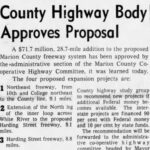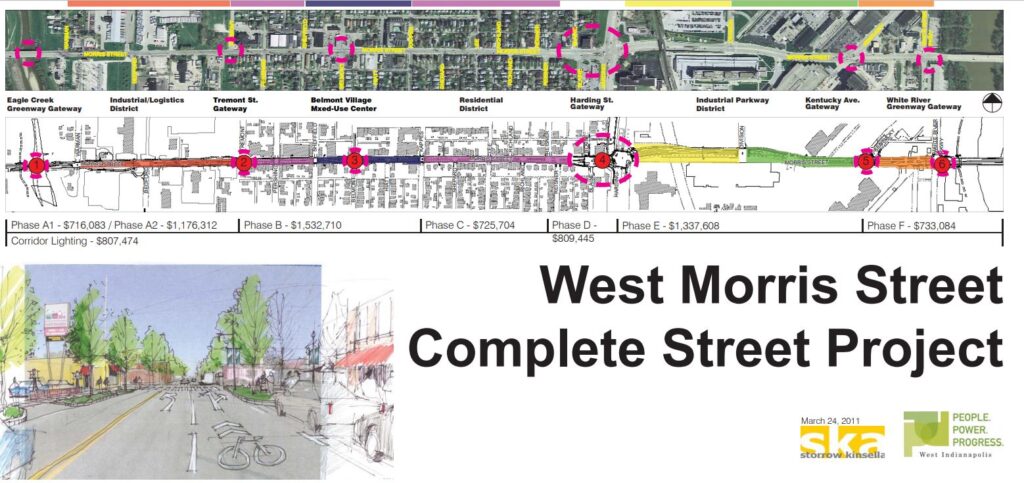When I-70 was constructed in the 1960s, West Indianapolis (W.I.) was cut in half. Homes, businesses, and communities were literally bulldozed. Then, plans for a Harding Freeway were announced to W.I. residents. After seeing what I-70 did to the community, neighbors mobilized, and the community immediately created what would be called the West Indianapolis Neighborhood Congress (WINC), organizing meetings with over 400 attendees. Once created and organized, WINC formally voted to improve Harding Street instead of expanding it beyond its original two lanes.
Harding Street TIF
Buyer Beware
 WINC successfully lobbied to delay the Harding Project and eventually stopped it, minimizing the number of homes and businesses lost from the I-70 Deal. However, West Indianapolis was already butchered – countless homes and businesses were lost, and the community fragmented. The Valley was completely cut in half, and the northern end of The Hill was separated from its neighbors. About 20 years later, Eli Lilly and Company breathed life into the failed Harding Project, and did exactly what WINC had rallied against two decades before.
WINC successfully lobbied to delay the Harding Project and eventually stopped it, minimizing the number of homes and businesses lost from the I-70 Deal. However, West Indianapolis was already butchered – countless homes and businesses were lost, and the community fragmented. The Valley was completely cut in half, and the northern end of The Hill was separated from its neighbors. About 20 years later, Eli Lilly and Company breathed life into the failed Harding Project, and did exactly what WINC had rallied against two decades before.
In 1991, the City of Indianapolis, in partnership with Eli Lilly, abruptly announced their plan for a new version of the Harding Project, despite community pushback. This new Harding Project was far worse for residents than the original plan. Not only would Harding be widened to six lanes, but a majority of families would be displaced from the Little Valley, and a section of Kentucky Avenue would be closed and transferred to Lilly (see maps below). The proposed closure of Kentucky Avenue would cut off Howard and Miller Streets – two of the primary streets leading into the Historic Black Community of W.I. – from access to Kentucky Ave.
WINC again led the charge in trying to save 40 homes and 15 businesses that were at risk. They formally opposed the project and requested that the City of Indianapolis and Eli Lilly Corporation require a social impact study as part of the plan. The study would address concerns that the expansion of Harding Street would “isolate people located east from its schools, parks, and other services.” The requests were ignored, and in 1991, a TIF was created for the new Harding Project. A $35 million bond was issued for the project, and Indianapolis Department of Metropolitan Development (DMD) simply stated they would work to “minimize adverse effects while maximizing the beneficial impacts of investment in the area.”
Before/After Highway
Before the Interstate.....
A picture of the northern half of Historic West Indianapolis: Families from The Valley can easily access Rhodius Park. Homes and businesses pepper Oliver, Morris, Howard, Harding.
After the interstate
Countless homes are removed across the northern boundaries of W.I., from east to west. There is no longer any connectivity between The Hill and The Valley. West Indianapolis is effectively split apart. The library, park, Community Center, and grocery stores are harder to access from east of Harding.
Before/After Harding Expansion
Before Harding Project
1979, before Harding Street Expansion: Homes and businesses line Harding Street. Historic Howard and Miller still connect to Kentucky. Businesses are active on almost every corner of Howard and all along Harding Street.
After Harding Project
Over 40 Homes and 20 businesses removed. The Little Valley is almost completely gone. The Valley is further separated from West Indy. Historic Howard and Miller Streets, which led into the heart of the Black community in W.I., lost their Kentucky Ave. connection. Kentucky Ave. taken over by Lilly. All businesses on Howard are completely cut off from Kentucky.
Bait and Switch
In 2007, it seemed like the tide might be turning for West Indianapolis. Our Community Development Corporation (CDC) was awarded the IMAGINE Grant. CDC created a Quality of Life Plan and a Morris Street Esplanade with the help of WINC and other area partners (The perfect community project for TIF funding!). The Morris Esplanade was a vision stretching from Eagle Creek to White River that would reconnect our community, and pave the way for small businesses to move back in to provide needed services to residents.
But the City of Indianapolis and Eli Lilly had other plans. It wasn’t enough for them to split our community apart and remove countless homes and businesses over the last 30 years. They also wanted the $4 million + yearly accrual of the Harding Project TIF. Remember, TIFs are supposed to be used to benefit the designated TIF area, since the money is generated by taxes paid by homeowners and businesses within its boundaries. However, sometime between 2001 and 2006, the City quietly merged the Downtown and Harding Street TIF districts so that instead of investing in the QOL Plan and Morris Esplanade, the City funneled Harding TIF money into downtown for work on the canal and other future projects for the downtown area. This marked the start of the city using the West Indianapolis TIF as a “piggy bank.”
Consequences and Questions
30 years later, the consequences of the Harding Street Project and shady TIF dealings are apparent. Not only do we bear the burden of industrial expansion, but our neighborhood continues to crumble as we see our funds diverted to downtown projects instead of healing our community. Jefferson Shreve, former City County Councilor for our district, when asked about the allocation of Harding TIF money, said, “It is not a piggy bank from which the administration is going to pull some dollars from here and some dollars from here to fix something else here”. However, the merger of TIF districts says differently. The extent of the abuse of the Harding Project TIF is unknown to this day, but documents WINC has obtained via FOIA requests point to around $70 million in transactions through the TIF. In 1970 we warned this project would “isolate people located east from its schools , parks, and other services“ and we were ignored. Some big questions remain: What happened to the $40 million in extra TIF money? Why was the QOL Plan and Morris Street Esplanade left unfunded for over ten years?
More of the Same
The newest trick the city used to invest in corporations instead of communities – and divert money to Big Pharma – is happening at the new Elanco Headquarters. Elanco, an animal pharmaceuticals company, is in negotiations to build its new headquarters at the old GM Stamping Plant site in The Valley. The City and State partnered to give Elanco a $225 BILLION corporate welfare package, once again taking from the Harding TIF to help fund it. Meanwhile, Morris Street Esplanade is still not funded. This Welfare package was so large, they had to funnel 8 million from the Consolidated TIF and the Harding Street TIF as well as create an entirely new $64 million TIF for the Elanco campus site. They did this after WINC spoke out against using funds from Harding to fund work for a project that would have its own TIF. Essentially, this shuffle of the deck allowed them to take money from Harding and Downtown Consolidated, then remove the boundaries, so they could create a new $60 million TIF on the same property.
See For Yourself
1991 A Series Bond for Harding Project
2006 Prop 391 Canal funding 8 million
2011 – Community plans Morris esplanade
2012 res 17 prop 15 amending declaratory res & redevelopment plan
2016 Prop 335 GM Expansion Area Added
2016 Prop 356 East Market Expansion Area Added
2019 E – 043 Morris / Bluff Road 1.8 Million
2019 Gateway Report 3.8m in 6.1 m paid 1.9 bal
1998 – 2019 Revenue Expenses from FOIA
2021 – r – 006 apply funds from 2018-r-007 with Ambrose to Elanco site





